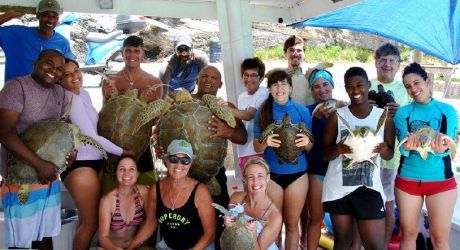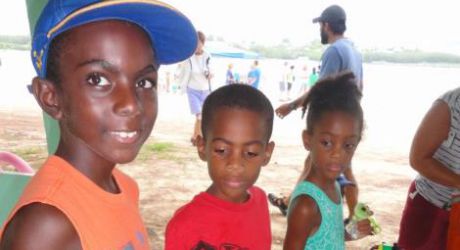Project Background
STC’s work in Bermuda constitutes the world’s longest-continuous research and conservation program focused on sea turtles in their marine environment. Celebrating its 50th anniversary in 2018, the project is carried out as a partnership between the Sea Turtle Conservancy and several Bermuda-based institutions.
Project Overview
The primary aim is to continue protecting and recovering endangered green sea turtles in the Western Atlantic and Caribbean through a rigorous in-water monitoring and conservation program around the island of Bermuda. Protection of the green turtles inhabiting Bermuda’s “developmental habitat” is contributing to the recovery of sea turtle populations at critical nesting beaches in Costa Rica, Panama, Mexico, Florida and many small Caribbean islands. The project also includes an annual training course for young biologists from Caribbean and Latin American nations that gives students practical experience conducting in-water turtle monitoring and helps build conservation capacity in the region.

Project Objectives
- To gather critical data about Bermuda’s Sea Turtles through a rigorous in-water research program looking at habitat use, health, growth rates, migratory behaviour, genetics, sex ratios and survival threats. Part of the study will include the use of satellite transmitters to monitor daily movements and behaviour of turtles around the island.
- To train aspiring biologists from communities in Latin America and the Caribbean in the proper methods for conducting in-water sea turtle monitoring in order to build conservation and research capacity in these critical locations for sea turtles.
- Conduct community outreach and education activities in Bermuda in order to raise awareness about threats facing these species and to build local support for sea turtle conservation.
Project Outcomes
Objective 1: Research
The projected completed a 49th year of gathering critical data about Bermuda’s sea turtles through a rigorous in-water research program looking at habitat use, health, growth rates, migratory behaviour, genetics, sex ratios and survival threats. Sampling with a new 1406 ft. net allowed the project to capture and collect data from 194 immature green turtles (Chelonia mydas) at 14 sites around the island. The turtles were tagged, biometric data were collected and the turtles were released unharmed at their capture sites. Of the 194 captures, 66 (34%) were recaptures of animals tagged in previous years.
A satellite transmitter was deployed on one near-adult-sized green turtle on 18 August 2017. This transmitter continues to function normally and is providing positional information at the time of report preparation. The turtle’s movements can be tracked online.
Tag returns provide important information about the destinations and the fate of turtles after they leave Bermuda waters.

Objective 2: Training
The Project offered its International Course on the Biology and Conservation of Sea Turtles. The course enabled us to train aspiring biologists from communities in Latin America and the Caribbean in the proper methods for conducting in-water sea turtle monitoring in order to build conservation and research capacity in these critical locations for sea turtles. The two-week course consisted of lectures, class discussions of assigned readings, a necropsy session, and ten days of field work.
The students learned to capture immature green turtles using the entrapment net and searched for hawksbills on reefs. They also gained extensive practical experience in collecting data from the turtles once they were captured and brought on board the research vessel. This year’s course participants were drawn from Anguilla, Bermuda, Canada, France, Guatemala, Jamaica, Mexico, and the United Kingdom.
Objective 3: Education
STC also aimed to raise broad public support, in Bermuda and far beyond for turtle conservation. As part of the 50th anniversary promotional activities and produced a new film about the project that covers some of the history and major accomplishments of the project. The film is now posted online and can be viewed here.
What Next?
This project continues into its 50th consecutive year in 2018. Plans are underway for a series of public lectures around Bermuda regarding sea turtles and the threats to their survival. The first of these lectures will take place in late April 2018 and will be conducted by David Godfrey of the Sea Turtle Conservancy. David’s presentation will begin on the black sand beaches of Tortuguero, Costa Rica, the largest remaining nesting site for green turtles in the Western Hemisphere – and trace the beginnings of a movement to study and protect sea turtles that spread from Tortuguero to Bermuda and eventually around the world.
Can I Visit the Project?
Yes, on a limited basis. Each August the Sea Turtle Conservancy conducts a special VIP day that allows sea turtle fans and aspiring biologists to get an up-close view of the project out on the water. A select group of observers is taken offshore by boat and allowed to help swim the net an look for turtles. Participants will see every aspect of the project up-close. Space is extremely limited and will need to be arranged well in advance directly with Sea Turtle Conservancy.
Project Background
STC has been working with local communities around Latin America and the Caribbean for nearly 60 years to monitor and protect some of the most important nesting sites for sea turtles. This work is protecting critical beach habitats and reducing threats such as poaching.
As a result of this long-term commitment to sea turtle protection, many breeding populations are starting to rebound, and green turtles in particular are showing signs of recovery. However, in order to fully protect sea turtles, conservation programs must be carried out at the places turtles go when they leave their nesting beaches. The near-shore habitats around Bermuda are among the most important in the world for juvenile green turtles, and this program is ensuring that STC can track the health of this in-water population, while continuing to reduce threats in the marine environment.
Project Objectives, Aims and Outcomes
Aims
Despite global advances in sea turtle conservation, threats to the survival of these imperilled species are on the rise. It is important that Sea Turtle Conservancy, the world’s oldest turtle research and conservation group, remain engaged in the diversity of issues affecting sea turtles and their habitats.
Through this proposal, STC is hoping to raise $20,000 to continue the Bermuda Turtle Project—a collaborative project carried out by the Sea Turtle Conservancy in partnership with the Bermuda Aquarium. The primary aim of this project is to continue protecting and recovering endangered green sea turtles in the Western Atlantic and Caribbean through a rigorous in-water monitoring and conservation program around the island of Bermuda.
Sea turtles do not nest in Bermuda; however, it’s clear, near-shore waters are filled with juvenile and sub-adult green turtles, which hatch at nesting sites around the Caribbean and Latin America and make their way to the productive seagrass beds around Bermuda to grow up. Protection of the green turtles inhabiting Bermuda’s “developmental habitat” is contributing to the recovery of sea turtle populations at critical nesting beaches in Costa Rica, Panama, Mexico, Florida and many small Caribbean islands.
The Bermuda Turtle Project also includes an annual training course for young biologists from Caribbean and Latin American nations that gives students practical experience conducting in-water turtle monitoring and helps build conservation capacity in the region.
Objectives
- To
gather critical data about Bermuda’s Sea Turtles through a rigorous in-water
research program looking at habitat use, health, growth rates, migratory behaviour,
genetics, sex ratios and survival threats. Part of the study will include the
use of satellite transmitters to monitor daily movements and behaviour of
turtles around the island.
- To train aspiring biologists from communities in Latin America and the Caribbean in the proper methods for conducting in-water sea turtle monitoring in order to build conservation and research capacity in these critical locations for sea turtles.
- Conduct community outreach and education activities in Bermuda in order to raise awareness about threats facing these species and to build local support for sea turtle conservation.
Outcomes
Through this project, STC will gather critical information about the juvenile green turtle population inhabiting the waters of Bermuda, which will help guide conservation actions that are helping recover green turtle populations throughout the Western Atlantic and Caribbean.
Critical data about sex ratios within the population will help us understand the ongoing impacts of global warming. Satellite tracking of select turtles will help us understand exactly how turtles are utilizing specific habitats and focus attention on the threats sea turtles face in different locations.
The research training course carried out in conjunction with this project will help train at least a dozen young biologists in the proper methods for monitoring in-water turtle populations, which will build the capacity for such research in other parts of the Caribbean and Latin America.
Lastly, this project will continue to raise awareness within Bermuda about the unique importance of this island as a developmental foraging ground for green turtles that originate from nesting sites around the Atlantic and Caribbean.
Project Partners & Community Involvement
This project is carried out as a partnership between the non-profit Sea Turtle Conservancy and the Bermuda Aquarium. Scientists from both organizations coordinate the project, oversee data collection and analysis, carry out community outreach and conduct the annual training course of young biologists.
The project is fully supported by the Government of Bermuda, and each year numerous members of the local community volunteer their time to help with the turtle research. Most importantly, through this sustained project, the entire nation of Bermuda has become aware of the unique role the island plays in the survival of green turtles in the Atlantic, despite the fact that turtles do not actively nest there. Consequently, Bermuda has some of the oldest and best enforced sea turtle protection laws in the world. This project helps maintain this high level of community support and effort on behalf of sea turtles in Bermuda.
How this project fits into a larger strategy
STC’s sustained research and conservation programs at numerous sites in the Caribbean and Latin America have been credited with saving the Atlantic green turtle from near extinction and improving the survival outlook for many other turtle populations.
The ongoing work to monitor and protect green turtles that reside in Bermuda during an important phase of their lives is helping recover this species in the Western Hemisphere. For nearly 60 years, STC has conducted sea turtle research and protection on the Caribbean coast of Central America.
This project fits well with the organization’s long-term strategies and goals for sea turtle recovery. The work in Bermuda compliments STC’s long-term conservation investments at nesting beaches in Costa Rica, Panama, Florida and elsewhere by ensuring that the growing numbers of young turtles hatching off these beaches are protected during their developmental years spent in the waters of Bermuda.